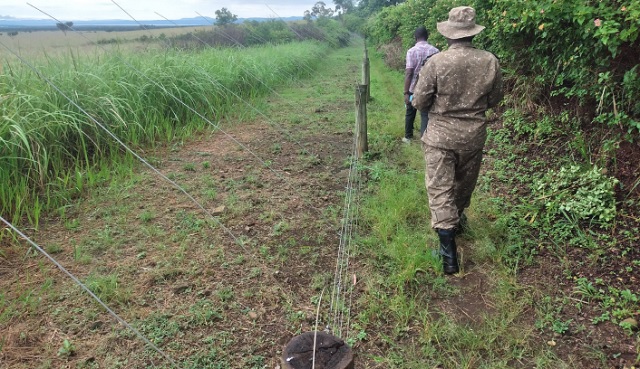By URN
The Uganda Wildlife Authority (UWA) has installed 81 kilometers of electric fencing around Murchison Falls National Park to combat human-wildlife conflict in the districts of Buliisa, Masindi, Nwoya, and Kiryandongo. Residents in these areas have been particularly affected by frequent invasions of wild animals into their communities.
Wilson Kagoro, the Warden for Community Conservation at Murchison Falls National Park, told Uganda Radio Network (URN) in an interview on Monday that they have fully covered 81 kilometers of the electric fencing process. He explains that in Buliisa they have so far covered 22 kilometers, with 10 kilometers still pending installation in the same district.
He says in Nwoya they have fully covered 44 kilometers, with work ongoing on an additional 10 kilometers. He adds that installation work is currently underway on 5 kilometers in Masindi and another 5 kilometers in Kiryandongo. According to Kagoro, the initiative aims to prevent wildlife from straying into human settlements, where they pose a threat to lives and livelihoods.
He noted that the electric fence will help address the growing human-wildlife conflicts that have led to loss of lives, destruction of property, and economic hardships, particularly in Buliisa District. He emphasized that the project seeks to protect both communities and wildlife, especially Uganda’s iconic lion population. By establishing clear boundaries, UWA hopes to foster peaceful coexistence between humans and animals while preserving biodiversity.
Kagoro explained that the initiative is part of a broader effort to mitigate conflict risks and protect Uganda’s rich biodiversity, adding that the fence is expected to reduce the frequency of human-wildlife encounters, safeguard wildlife populations, and support the livelihoods of communities living near the park.
He, however, says the installation work of the electric fence is being hampered by lack of a clear boundary between the community and the park. This requires them to first engage the communities before any work can be undertaken. He is optimistic that the installation will soon cover all the 433 kilometers of the entire boundary perimeter of the park.
Residents living near Murchison Falls National Park have long protested against the frequent invasions of wild animals, which have resulted in deaths and widespread crop destruction. A week ago, residents near Murchison Falls National Park in Kiryandongo protested over a surge in elephant invasions that have caused widespread destruction to crops and threatened their livelihoods.
This followed reports that stray elephants raided Bunyama Village in Kyankende, devastating over 10 acres of farmland. Affected crops included banana plantations, beans, cassava, maize, rice, and sweet potatoes. Locals said the destruction has left farmers helpless and desperate.
In February 2025, a tragic incident occurred when a 53-year-old woman, Eunice Kutegeka of Kigoya village, was killed by an elephant while collecting firewood near her home. Her four-year-old grandson, Robert Niwagaba, suffered critical injuries to the face, back, chest, and buttocks and was rushed to Buliisa General Hospital for treatment. In July 2024, farmers in Buliisa Sub-County staged a protest at the sub-county headquarters, demanding compensation for crops lost, injuries sustained, and lives lost due to wild animal attacks.
Since 2022, at least 18 people have been killed and numerous others injured by elephants and buffalo in Buliisa District alone. In August 2022, more than 1,000 residents from over 20 villages neighboring the park—including Butiaba, Buliisa, Ngwedu, Biiso, and Buliisa Town Council—petitioned UWA for urgent intervention. They reported massive destruction of cassava, maize, beans, sweet potatoes, and bananas by wild animals.
The petitioners demanded that UWA construct an electric fence around Murchison Falls National Park to prevent further invasions and compensate residents for lost crops and injuries caused by wild animals. The electric fence initiative marks a significant step in addressing long-standing human-wildlife conflicts.
However, community leaders insist that the process must be completed swiftly to prevent further loss of life and livelihoods. UWA has assured residents that the installation will continue as planned, with additional security measures being explored to protect both people and wildlife.




